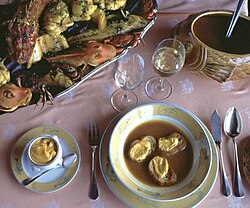 A traditional bouillabaisse from Marseille, with the fish served separately after the soup | |
| Type | Stew |
|---|---|
| Place of origin | France |
| Region or state | Provence |
| Main ingredients | Fish (Scorpionfish, sea robin, European conger) herbs spices |
Bouillabaisse (/ˌbuːjəˈbɛs/ BOO-yə-BESS, US also /-ˈbeɪs/ -BAYSS, French: [bujabɛ(ː)s] ; Provençal: bolhabaissa [ˌbuʎaˈβajsɔ, ˌbujaˈbajsɔ]) is a traditional Provençal fish soup originating in the port city of Marseille. The word is originally a compound of the two Provençal verbs bolhir ('to boil') and abaissar ('to reduce heat', i.e. 'simmer').
Bouillabaisse was originally a dish made by Marseille fishermen, using bony rockfish, which they were unable to sell to restaurants or markets. There are at least three kinds of fish in a traditional bouillabaisse: typically red rascasse (Scorpaena scrofa); sea robin; and European conger. It can also include gilt-head bream, turbot, monkfish, mullet, or European hake. It usually also includes shellfish and other seafood such as sea urchins, mussels, velvet crabs, spider crabs, or octopus. More expensive versions may add langoustine (Dublin Bay prawn; Norway lobster), though this was not part of the traditional dish made by Marseille fishermen. Vegetables such as leeks, onions, tomatoes, celery, and potatoes are simmered together with the broth and served with the fish. The broth is traditionally served with rouille, a mayonnaise made of olive oil, garlic, saffron, and cayenne pepper, on grilled slices of bread.
What makes a bouillabaisse different from other fish soups is the selection of Provençal herbs and spices in the broth; the use of bony local Mediterranean fish; the way the fish are added one at a time, and brought to a boil; and the method of serving. In Marseille, the broth is served first in a soup plate with slices of bread and rouille, then the fish is served separately on a large platter (see image at top); or, more simply, as Julia Child suggests, the fish and broth are brought to the table separately and served together in large soup plates.[1]
- ^ "Serve the bouillon very hot with the rouille in soup plates with thick slices of country bread rubbed with garlic. Then serve the fish and the potatoes (Jean-Louis André, Cuisines des pays de France, Éditions du Chêne, 2001) "The fish are served on a platter, and the broth in a tureen, and you eat both together in large soup plates." (Julia Child, The French Chef Cookbook., Knopf, 1968)